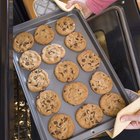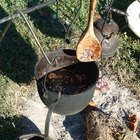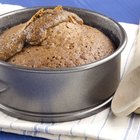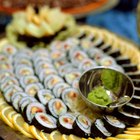Most home ranges come supplied with a heavy-duty broiler pan for use with their built-in broiling element. They're designed for the purpose, made from heavy metal and with a drip-through grate to let fat escape from the cooking area. Unfortunately they sometimes go missing, and at times their height can make it difficult to place your food at the right distance from the broiler element. In those situations, a regular baking sheet can make an acceptable alternative.
Getting Your Broil On
The broiler element in an electric or gas oven creates an intense heat, but it's not the heat itself that makes it such a rapid cooking method. Air is a poor conductor of heat, and even the heat of your broiler element doesn't change that. Instead, your broiler element cooks primarily by infrared radiation. Think of it as a turbocharged version of the sunburn you get at the beach, at temperatures well below those of an oven. The broiler's high-energy infrared emissions brown and sear the food's surfaces quickly, like a grill, though in this case the heat comes from above rather than below.
Sheet Pan vs. Broiler Pan
There are some obvious physical differences between a sheet pan and a broiler pan. Broiler pans are made of heavier, more rigid metal than sheet pans, so they're more resistant to the broiler's extreme heat. Sheet pans can often buckle and warp when they're used this way, so you should opt either for a very heavy sheet pan that resists warping or a very inexpensive one you can discard or recycle afterwards. The major advantage of a sheet pan for use under your broiler is their larger surface area. Broiler pans are relatively small and can only hold a few steaks or chops. A sheet pan can accommodate enough portions for a large gathering.
The Fat Problem
One of the virtues of broiling is that the fat in your meats tends to render out and drip away through the pan's grate. You lose that advantage with a sheet pan, and might need to improvise. One option is to find a metal cooling rack roughly the same size as your sheet pan, and place the foods on the rack. If you find that your food tends to stick to the rack, or sag and droop between its bars, line the rack with aluminum foil and then puncture it in several places with a skewer to let the fat escape.
Stuck to You
Whether you use your sheet pan with or without a rack, you'll encounter a problem with foods and cooking juices sticking to your pan. You can minimize this by brushing the rack and pan with a high-temperature oil such as safflower oil, or using a special high-temperature pan spray. Don't line the pan with parchment paper to speed cleanup, because the broiler can ignite your parchment in mere moments. Instead, line the pan with heavy-duty aluminum foil. Non-stick foil is available from some manufacturers, or you can spray or brush ordinary foil with the same kinds of oil or pan spray.
Related Articles

What Is Charbroiling?
Convection Broiling Vs. Convection ...

How to Rotisserie Cook Without a ...

What Depth Is Considered a Shallow ...

Why Does Food Stick to a Non Stick Pan?

Advantages & Disadvantages of Dry ...

Cooking Poultry With a Convection Vs. ...

How to Cook With Stainless-Steel Frying ...

Anodized Vs. Teflon in Cookware

How to Cook With Radiant Heat

Can I Put Canola Oil in a Spray Bottle?

What Causes Uneven Baking in Cookies?

Wood Fired Pizza Nutrition

How to Use Dark Baking Pans

Is Revere Ware Aluminum?

The Difference Between Grilled & ...

How to Clean Burnt Spills on Silicone ...

The Difference Between Grill & Griddle

How to Bake With a Pizza Screen

Are Aluminum Serving Pieces Safe for ...
References
- On Food and Cooking: The Science and Lore of the Kitchen; Harold McGee
- The Kitchn: Why Do My Baking Sheets Buckle In the Oven?
Resources
Writer Bio
Fred Decker is a trained chef and prolific freelance writer. In previous careers, he sold insurance and mutual funds, and was a longtime retailer. He was educated at Memorial University of Newfoundland and the Northern Alberta Institute of Technology. His articles have appeared on numerous home and garden sites including GoneOutdoors, TheNest and eHow.